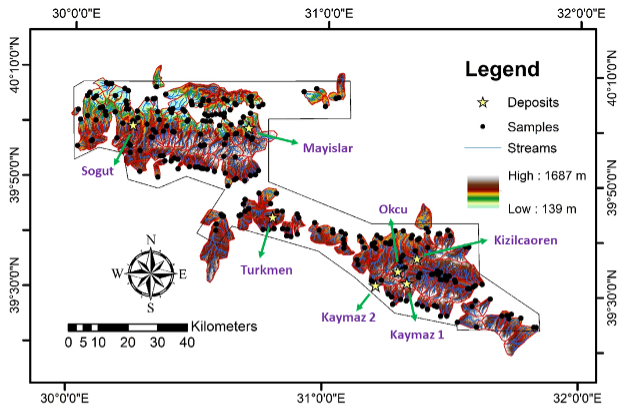Weighting of BLEG data with drainage and catchment properties to enhance Au anomalies
Dr. Behnam Sadeghi with Profs. Huseyin Yilmaz and Franco Pirajno, has published this paper in journal “Geochemistry/Chemie der Erde”, based on bulk leachable extractable gold (BLEG) data in Western Turkey, considering several other relevant parameters such catchments’ areas, slopes and curvatures plus the sinuosity index of the streams per catchment.

Abstract
This research aims to take the effect of drainage sediment dilution into consideration by using catchment weighted-bulk leachable extractable gold (CW-BLEG) data in order to enhance and recognize Au anomalies. As a case study, an area in the Eskisehir region in Western Turkey was selected. In this area, gold-bearing crystalline quartz veins, of probable orogenic type, containing up to 20 g/t Au, occur in low-grade schists and marbles of the Karakaya Complex in the vicinity of the Sogut area. To classify the final geochemical maps of the BLEG data to differentiate Au anomalies from background, the singularity model was applied. After that, in order to take the sediments dilution effect (DE) into account, the other important factors in the study area such as the sinuosity index (SI) of the stream sediments per catchment, and the topography slope and area of each catchment were taken into consideration and implemented on the BLEG data. To do so, the CW-BLEG models based on the relation between the Au concentrations and each factor (i.e., C × sinuosity as DE-sinuosity, C × slope as DE-slope, and C × area as DE-area) were generated. Because of the insufficient number of known mineral deposits within the study area to evaluate the effectiveness of the models statistically, the models generated were compared with each other and studied using cross-validation. It demonstrated that the DE-area and DE-sinuosity models work better than the other model in recognizing strong and very strong anomalies considering the known mineral deposits. The cross-validation results show that the DE-area model provides a more robust result compared the other models. Considering the models generated, the very strong and strong Au anomalies in the western part of the study area are corresponded to the known gold mineralization (e.g., Sogut and Mayislar) hosted by the Karakaya Complex, and the anomalies in the eastern and central parts of the study area are associated with the Damdaca mineralization.
Full link to this paper is https://www.sciencedirect.com/science/article/abs/pii/S0009281920301446
![]()
